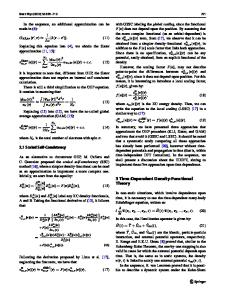Functional Context Theory of Learning
- PDF / 1,085,430 Bytes
- 76 Pages / 547.087 x 737.008 pts Page_size
- 121 Downloads / 418 Views
Facial Expression ▶ Consciousness and Emotion: Attentive vs. Preattentive Elaboration of Face Processing
Facial Expression Learning EILEEN OBERWELLAND1, WHITNEY MATTSON2, NAOMI EKAS2, DANIEL S. MESSINGER2 1 Leiden University, The Netherlands 2 University of Miami, Coral Gables, FL, USA
Synonyms Emotional Expression Development
Definition Facial expression learning. Facial expressions are produced as the muscles of the face contract, creating facial configurations that serve communicative and emotional functions. Facial expression learning involves changes in the coordination of facial muscles such that new configurations and patterns of facial action emerge.
Theoretical Background Facial expression learning is typically a focus of theories of emotional development. These theories differ in the importance they assign to innate versus environmental factors, and the degree to which they emphasize change in the form of facial expressions with age. Learning theory argues that the development of facial expression
proceeds through both imitation and reinforcement. Infants, as young as a couple of hours of age, appear to imitate mouth opening and tongue protrusion. Early imitation would allow infants to produce multiple types of facial expressions that they perceive others performing. Reinforcement increases the rate of a target behavior (e.g., infant smiling) through an environmental contingency (e.g., excited talking) over the course of repeated pairings or trials. Imitation and reinforcement are logically necessary to multiple accounts of facial expression development. Discrete Emotion Theory (DET) holds that the emotions of surprise, interest, joy, anger, sadness, fear, and disgust each have their own distinct facial expression. After the first months of life, infants are thought to possess the same universal and distinguishable prototypic emotion expressions as adults. These prototypic expressions are produced by affect programs. Affect programs are neurophysiological mechanisms that link subjectively felt emotions to facial expressions in an invariant fashion across the lifespan. Changes in facial expressions are thought to be due to maturation and the influence of societal display rules on underlying expressions. Cognitive theories of facial expression suggest that newborns begin life with three primary emotion expressions: distress, pleasure, and interest. As cognitive functions grow in complexity across development, these facial expressions become more differentiated in their presentation and more tightly linked to specific contexts. The cognitive concepts that are necessary to develop the basic emotions of surprise, interest, joy, anger, sadness, fear, and disgust develop over the first 6–8 months of life and consist of perceptual and representational abilities. For example, the expression of anger requires the ability to represent a goal and realize that the goal has been blocked. Functionalist theories of emotion view facial expressions as components of emotion. Emotion, in turn, is conceptualized as attempt
Data Loading...











